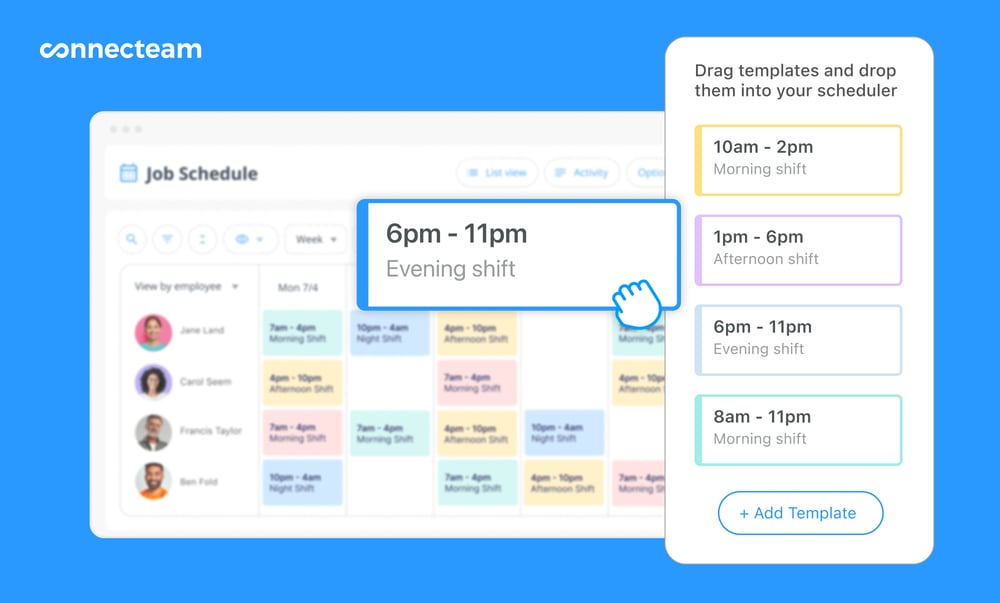Strategic call center management decisions increase customer satisfaction and reduce operational costs and employee turnover. Here, we outline 8 best practices you can start using today, plus top metrics to watch.
Managing call centers offers you the unique opportunity to solve customers’ problems while improving their perception of your business.
But call center management is tricky. For instance, how do you ensure shift coverage while minimizing operational costs? Should you invest in comprehensive training when there’s such high employee turnover? Without addressing topics like these, you risk ineffective service delivery, diminished customer satisfaction, and reduced profits.
We’ve got your back. In this guide, we outline considerations across training, scheduling, and more so you can start making changes today. We also list 8 call center best practices, key metrics to track, and ways to use call center technology to your advantage.
Key Takeaways
- Call center management includes training staff, developing protocols, resolving customer problems, and setting and tracking performance metrics.
- Effective call center management leads to reduced costs and happier customers and employees.
- Best practices for call center management include improving agents’ decision-making, incentivizing performance, and preventing burnout with optimized scheduling.
- To assess the effectiveness of your call center management, track key metrics like costs per call and customer satisfaction rates.
- Call center software makes it easier to track and analyze critical call information and stay compliant. Core features include protocol storage, ticketing, scheduling, and training.
What Is Call Center Management?
Call center management refers to the planning and execution of call center operations.
Managing call centers includes tasks like providing agent training, developing call scripts, choosing appropriate technology solutions, and coordinating with other business areas to solve customer problems.
The goal is to provide effective customer support and maximize customer satisfaction while optimizing call center costs.
Why Is Strategic Call Center Management Important?
Effective call center management elevates your company’s reputation. It can greatly boost customer satisfaction levels, leading to repeat purchases and recommendations.
In addition, you’ll retain more skilled contact center employees—leading to lower staffing costs.
Furthermore, strategic call center practices can:
- Reduce call volumes, wait times, and call duration by solving customer problems.
- Produce faster, solution-targeted agent decisions thanks to comprehensive training.
- Reduce operational costs by minimizing transfers and escalations.
- Improve call center team dissatisfaction by preventing burnout.
- Increase customer experience through optimal shift coverage.
8 Best Practices for Call Center Management
Here are some call center best practices you can start implementing today.
Establish standard operating procedures
Standard operating procedures (SOPs) detail essential processes and guidelines so your call center agents can provide consistent, high-quality customer service.
Call center SOPs commonly include:
- Call handling protocols, including security questions and information gathering
- Call scripts
- Customer communication etiquette
- Service levels, such as the percentage of answered calls in a certain timeframe
- Common questions and answers
- Escalation to managers or specialists
- Customer complaint processes
- Privacy and data security rules
- Performance targets and incentives
- Shift and schedule guidelines
- Customer feedback processes
- Agent feedback processes
- Reporting concerns
Ensure your SOPs are well-structured and easily accessible so agents can quickly scan them during calls.
💡Pro Tip:
SOP management software helps you organize your SOP content and quiz employees on key procedures. Check out our selection of the best SOP software in 2025.
Enable agents to make decisions
Putting customers through long calls, transfers, and escalations can negatively impact customer experience and increase your costs. A better alternative is letting specialist and non-specialist agents make decisions without escalation or transfers.
This starts with removing unnecessary decision-making restrictions and reducing escalation requirements on common issues like refunds, billing, and product defects.
Provide holistic training
Your call center training must include call protocols, escalation routes, performance targets, common questions, and communication etiquette. Training should be collaborative and engaging so agents can absorb it more easily. Make sure to encourage questions and illustrate mock agent-customer conversations.
Don’t only provide training at the start of employment. Create regular workshops focusing on specific skills and recent team challenges. For instance, you could run monthly workshops on:
- Customer centricity
- Empathy and de-escalation
- Problem-solving and decision-making
- Wellness and self-care
- Cross-team cooperation
📚This Might Interest you:
Read our guide on the best employee training solutions featuring in-depth reviews of the leading training tools 2025.
Incentivize agents and supervisors
Call center employees may perform better with performance-related pay. Incentivizing agents and supervisors to hit key targets can reduce operational costs, improve customer satisfaction, and lower turnover.
The trick is finding a compensation structure that motivates staff while increasing performance. For instance, consider:
- Fixed bonuses to offer when employees hit targets—like a 20% call time reduction.
- Variable bonuses that increase with achievement levels—say, $2 for each positive customer satisfaction score received.
💡Pro Tip:
To track targets and identify top performers, find a call center software solution that works for you. You should analyze data like call volumes, wait times, and customer satisfaction scores.
Empower agents with business data
With daily access to critical business information, your agents can respond to customer queries with speed and knowledge.
Aim to communicate big updates like corporate mergers, privacy breaches, or billing failures ASAP. Your top managers should send such updates by email or team communication app to reflect urgency and importance.
🧠Did You Know?
You can send any company update and reach every call center agent with Connecteam. Ensures nobody misses important info by sending instant notifications to workers’ devices and pinning them to the top of your agents’ company feeds.
However, it’s not just big news that enables agents to improve customer outcomes. Your call center supervisors or other department leads should provide weekly updates on product changes, key marketing campaigns, and other relevant info to pre-empt customer issues.

Prevent burnout with optimized scheduling
Optimized team schedules help prevent accidental absences and ensure optimal shift coverage. They balance several key factors, including business needs, customer demand, employee availability, and work-life balance.
With a focus on work-life balance, optimized schedules can reduce employee burnout—a big factor in contact center turnover.
Here are our top tips for reducing burnout with optimized scheduling:
- Keep shifts flexible and allow agents to self-assign based on their preferences.
- Let employees swap shifts at the last minute to account for personal needs.
- Avoid back-to-back shifts with easily accessible employee availability.
- Assign enough employees to busy shifts to provide time for regular breaks while minimizing customer wait times.
🧠 Did You Know:
Connecteam’s powerful free employee scheduling app makes scheduling your callcenter agents a breeze. Quickly build schedules with templates, duplications, and recurring shifts and send them out to your team with just a few clicks.
Integrate your software solutions
Your team likely uses a combination of call center technology products to track customer comms, investigate and solve issues, communicate internally, and more. These might include:
- Help desk ticketing software
- Customer relationship management (CRM) software
- Customer billing software
- Workforce management software
- Email software
You’ll want to integrate your main help desk software with as many other solutions as possible so your agents can find relevant information quickly.
For instance, integrating it with a CRM solution enables your staff to check critical data instantly. This might include order details and past communications via email and social media.
Capture agent feedback
Support agents have direct insight into customer issues and perceptions, including product user-friendliness, technical inefficiencies, the quality of your business communications, and more.
Collecting agent feedback enables you to enhance your service, improve customer experience, and outpace competitors. You can capture this efficiently using employee survey software.
📚This Might Interest You:
Discover our top picks for employee survey tools.
Hold weekly, monthly, or quarterly meetings where agents and supervisors can pass on recurring customer issues to teams like product and marketing. Additionally, invite agents to fill out brief digital feedback forms after calls.
7 Metrics To Track for Optimal Call Center Management
Periodically measure the following call center metrics—say, weekly or monthly—to check if you’re on the right track.
Average handling time (AHT)
The average handling time (AHT) is the average duration of a handled call—which is a call that an agent answers. While lowering AHT is important, you should do this by resolving issues efficiently and correctly rather than rushing to finish calls without clear solutions.
Attain this by offering comprehensive training that covers problem-solving skills and making business data accessible to agents.
How to calculate AHT
Average handling time = Sum of call durations / Number of handled calls
For instance, say you handled 1,000 calls with a total duration of 5,000 minutes last week. You’d calculate:
Average handling time = 5,000 / 1,000 = 5 minutes
First call resolution rate (FCR)
The first call resolution (FCR) rate measures how often problems are resolved in just one call. It’s expressed as a percentage.
Maximize your FCR rate to keep call center costs low and customers happy. To do this, integrate your contact center apps and make your SOP and product info readily available to agents.
How to calculate FCR
First call resolution rate = (Number of calls with a first call resolution / Number of handled calls) x 100
Let’s say that last month your team handled a total of 10,000 calls, and 5,000 of them had a resolution in the first call. You’d calculate:
First call resolution rate = (5,000 / 10,000) x 100 = 0.5 x 100 = 50%
Call abandonment rate
Calls are “abandoned” when they don’t get put through to agents. Customers typically abandon calls because of long waiting times, confusing call menus, or technical issues.
While they result in fewer handled calls and less strain on agents, abandoned calls can leave customers’ issues unresolved. In turn, customers may stop doing business with you or damage your public reputation.
So, minimize your call abandonment rate by staffing shifts appropriately and incentivizing employees to handle calls quickly and efficiently.
How to calculate call abandonment rate
Call abandonment rate = Number of abandoned calls / (Number of abandoned calls + Number of handled calls) x 100
Say you had 2,000 abandoned calls and 7,000 handled calls last month. You’d calculate:
Call abandonment rate = 2,000 / (2,000 + 7,000) x 100 = 2,000 / 9,000 x 100 = 0.222 x 100 = 22.2%
Total calls
Your total number of calls includes handled and abandoned calls.
Monitoring this metric helps you identify trends, such as an increase in calls. It can also help you create solutions for handling calls more efficiently (like hiring more staff) or reducing total calls.
You can decrease calls by resolving underlying customer issues and offering self-service alternatives like web-based FAQs and help articles. Decreasing call volumes—both handled and abandoned—can reduce your call center costs and employee burnout.
How to calculate total calls
Total calls = Number of handled calls + Number of abandoned calls
For instance, say last week your center had 4,200 handled calls and 800 abandoned calls. You’d calculate:
Total calls = 4,200 + 800 = 5,000
Customer satisfaction score (CSAT) and rate
A call center’s ultimate goal is high customer satisfaction.
Tracking customer satisfaction makes it easier to see if you need to improve or if you’re meeting customers’ needs and expectations. Do this through regular satisfaction surveys.
Ask customers a 1-5 Likert scale question after each call, like “How satisfied are you with the customer service you received today?” (1 is “extremely unsatisfied,” while 5 is “extremely satisfied.”)
Once your data is in, you have two key metrics to track:
- Average customer satisfaction score (CSAT), which tells you how satisfied your base is overall from 1 to 5.
- Customer satisfaction rate, which tells you the percentage of satisfied customers who have received support.
Increasing these two scores is challenging yet achievable. It requires combining different best practices—including excellent agent training, performance incentivization, and agent feedback.
How to calculate CSAT score and customer satisfaction rate
Average customer satisfaction score = Sum of all customer satisfaction scores / Total number of customer responses
Customer satisfaction rate = (Number of positive customer satisfaction scores / Total number of customer responses) x 100
So, let’s say that over the past year, you received 10,000 customer satisfaction survey responses, and the sum of all scores is 43,000. Imagine 7,500 responses are positive, with a 4- or 5-star score.
You’d calculate:
Average customer satisfaction score = 43,000 / 10,000 = 4.3
Customer satisfaction rate = 7,500 / 10,000 x 100 = 7.5 x 100 = 75%
Cost per call
Your cost per call is a measure of call center efficiency. The lower it is, the more cost-effectively you’re operating.
However, ensure you reduce your cost per call by solving customer problems quickly and accurately—not by reducing investment in training or employee incentives.
Achieve this by enhancing agents’ problem-solving and decision-making skills. Also, make business updates and software tools easily accessible.
How to calculate cost per call
Cost per call = Total call center operational and labor costs / Number of handled calls
Say your call center’s yearly operational and labor costs were $250,000, and your team handled 100,000 calls. You’d calculate:
Cost per call ($) = 250,000 / 100,000 = 2.5
🧠Did you Know?
In the US, federal and state laws mandate how you operate your call center. You must check which laws apply to your business and ensure you comply across areas, including agent training and data collection. For instance, regulations may affect how you pay overtime wages, manage consent for call monitoring, and store customer financial information.
Use Connecteam To Manage Call Center Operations
Connecteam is a leading call center scheduling software that enables you to manage team members and operations more efficiently. It combines scheduling tools with SOP storage, digital forms, training, and more.
Here are the top ways Connecteam enhances your call center management.
Effortless scheduling
Scheduling call center shifts with Connecteam’s employee scheduling app is a breeze. Build and reuse templates for common shift types, like evening ones, and repeat shifts to save time. Agents can self-assign, swap, or accept assigned shifts with one touch. You can even schedule open shifts for anyone to claim.
Plus, you can easily check individuals’ qualifications, availability, and shift preferences. So, you can reach your optimal coverage without risking last-minute dropouts, burnout, or lack of specialist knowledge. Ultimately, this will lead to higher staff well-being and more efficient call handling.
SOP and script access
Connecteam lets you store your SOPs in a company knowledge base and break them into digestible parts. Employees can search for words or phrases inside documents, which helps solve problems and complete calls faster. In addition, you can store multiple call scripts that agents can read on either desktop or mobile.
This easy access to structured information can lower your average handling time and increase your first call resolution rate.
Connecteam also keeps an audit trail of changes made to your SOP. Having historical SOP versions in one place helps you stay compliant with state and federal regulations. For instance, your audit trail can show that you’ve instructed employees to follow data protection policies in the case of an inspection.
Automated feedback forms
With Connecteam, you can automate evaluation forms for agents to complete after calls. You’ll gather numerical data, like customer satisfaction, and other data, such as problem details and causes.
Analyzing your evaluation forms can enable other business areas, such as billing, to fix recurring issues. So, by executing this feedback loop, you can see lower call volumes and happier customers.

Streamlined training
Connecteam’s employee training software lets you provide and track training, streamlining your center operation. Offering training content that’s in one place and accessible from anywhere is especially handy for agents working remotely or across geographical regions.
You can monitor individuals’ training module progress in real time to instantly confirm who’s ready to start taking calls or begin a specialist role.
Conclusion
Running call centers effectively is key to achieving high customer satisfaction. But with so many moving parts—from training to protocols to call resolutions—it’s hard to know which changes to make first.
Call center best practices like incentivizing employees, enhancing problem-solving skills, and sharing feedback with other departments help you make measurable improvements, including lower costs per call.
Finally, call center apps like Connecteam let you gather vital information and schedules in one place. You can organize your SOPs, track employee training, streamline schedules, and more.
Try Connecteam for free today.
FAQs
What does a call center manager do?
A call center manager must hit strategic targets—like reducing call volumes, average call duration, and cost per call. They should also ensure legal and operational requirements are outlined in SOPs and that agents receive high-quality training.
How do you manage a call center effectively?
To manage a call center effectively, optimize several key factors, including escalation and communication guidelines. Equip agents with technology and product information. Finally, track your progress on key metrics, such as customer satisfaction, and make improvements where necessary.



